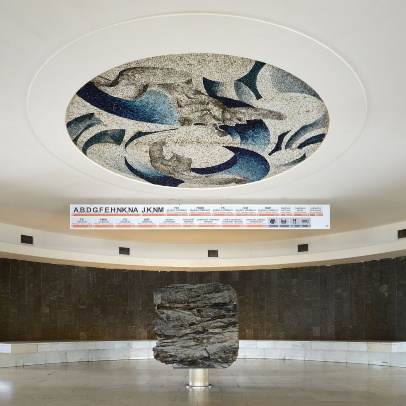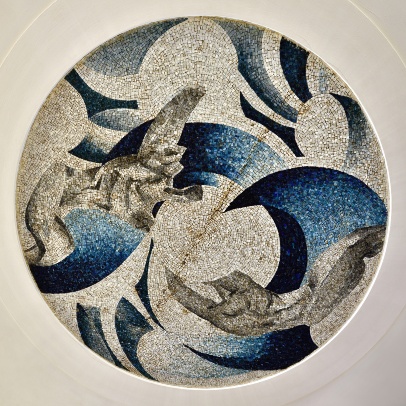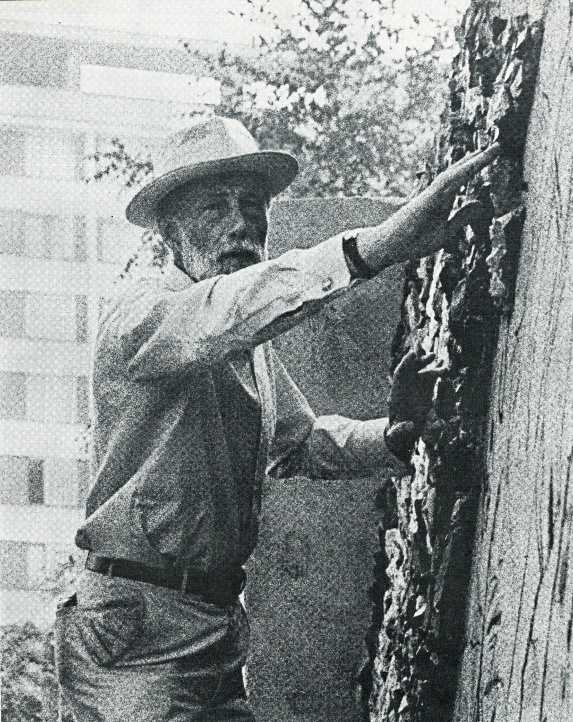Name: Takeoff / The Development of Human Thinking
Author: Martin Sladký
Dating: 1973–1974
Location: in the interior on the ceiling in the vestibule of the circular auditorium on the VŠB-TUO campus in Poruba
Execution: a circular glass ceiling mosaic of chipped glass enamel with a diameter of 300 cm
HEAVENLY CEILING
The academic painter Martin Sladký was the author of a visual art design of the first VŠB building in 1973. There was an intention to “paint the ceiling of the united auditoriums” among other artworks and design elements (signs, orientation system, wall tiling, etc.). The author of the design, Martin Sladký, himself made a proposal for an intended artistic ceiling in the lobby of the circular auditorium. A coal boulder, previously located in the entrance lobby of the Rectorate building, where it was moved towards the end of 1972 from the second floor of the blue pavilion of the Faculty of Metallurgy and Geology in Silesian Ostrava, was to be installed below the artwork located on a ceiling in the lobby.
Martin Sladký prepared the design for the mosaic Takeoff using an encaustic technique (hot wax painting) in 1973. The theme and design had to be approved by the artistic committee of the Czech Fund of Fine Arts, where the theme of the work assignment was defined as the Development of Human Thinking. The author of the design for the circular auditorium, architect Milena Vitoulová, did not participate in the concept of the artwork and its incorporation into the interior of the lobby, because at that time she was on maternity leave. In her opinion, the location and impression of the work, including the installation of the boulder in the centre of the lobby, did not correspond to the original author’s architectural intention. The architect imagined that the circular auditorium would become a meeting point where students and teachers could informally gather. In particular, the coal boulder (the second largest piece of coal mined in the Czech Republic) in a central position just below a circular mosaic in the centre of the space, however, does not allow for any free movement and defines the walking paths around a perimeter of the auditorium space. At present (autumn 2020), the relocation of the boulder is being considered.
Martin Sladký conceived the given topic The Development of Human Thinking freely, in a decorative and abstract manner, in cool blue, grey and white tones. The mosaic was entitled Takeoff. In other works of art by this author depicting the same subject, the form of a male figure standing between circular shapes reminiscent of space bodies is more clearly recognizable. In the mosaic in the lobby of the circle auditoriums, the motif of the figures is less obvious, and we can assume that they are two stylized male bodies in heavenly space. This interpretation is also supported by both the circular mosaic itself and the chosen colours. The author himself, in an interview about the mosaic, commented on it this way: “You know, I wanted the young people who would have some work underground to enjoy a lot of cheerful brightness and the blue colour above them at their university.” The author’s words relate to the mining focus of the university at the time when the mosaic was created (the interview is from 1976). Not many of today’s undergraduate students ever work underground.
The academics passing by can still look for their own interpretations in the shapes dynamically swirling around a circular centre if they raise their eyes to the ceiling while going through the lobby. The contemporary text describes the idea of the work as “trying to express the eternal human desire to explore the world, to overcome nature, to benefit humanity – Icarian and Promethean motives” that represented the symbolism appropriate for the purpose of the space on the university campus. The reference to Prometheus in an artwork appears on the campus for the second time. In 1968, it was mentioned by the sculptor Vladislav Gajda, the author of the relief above the main entrance to the University building.
The fact that Prometheus himself used tricks in favour of humans when negotiating with the authority of the Olympian deity represents the other side of this legend, the interpretation of which today is up to contemporary academia.


